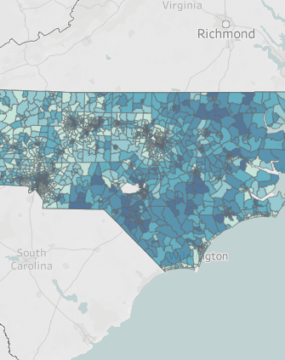Carolina Demographics
Keep up with our latest demographic insights

Key takeaways: A college degree is associated with several positive life outcomes, ranging from greater financial security to better health. However, over the past decade, returns on postsecondary degrees have diminished both nationwide and in North Carolina. We reported recently that the level of educational attainment among North Carolina’s degree-earners continues to rise. This is related, in part, to a shifting job market favoring higher-skilled workers. However, as more individuals seek out greater levels of…

A complete and accurate census count is incredibly important. The census shapes how billions of dollars in federal funding are distributed, how congressional seats are apportioned, and how communities plan for their future residents. But certain populations have historically been undercounted in the census, due to a variety of factors. Undercounting these communities skews the census data that’s used to ensure fair political representation and support community planning. To help North Carolina achieve a complete…

Nationally, 46% of women aged 25-64 reported having an associate degree or higher in 2017 compared to 39% of men, a gap of seven percentage points. In North Carolina, this gap was even larger: 48% of women had an associate degree or higher compared to 38% of men, a gap of 10 percentage points.Compared to men, North Carolina women are more likely to report the completion of an associate degree (11.9% vs. 8.3%), bachelor’s (23.3% vs. 20.1%), or master’s (9.8% vs. 6.8%) degree. Men are slightly more likely than women to hold a professional degree (1.8% vs. 1.7%) or a doctorate (1.3% vs. 1.1%).

Forty-three percent of North Carolina’s adults aged 25-64 held some type of postsecondary degree in 2017—just over 2.3 million residents in the state. This share has risen five percentage points since 2010, and ten since 2000. In total, North Carolina gained 932K working-age adults with an Associate degree or higher from 2000 to 2017, and among these adults, the level of degree attainment continues to rise. In 2000, the majority of NC adults aged 25-64…

2,135,568 North Carolina households headed by a married couple or a householder with an unmarried partner. This represents 54% of all NC households. 5.8% Share of North Carolina households headed by a householder with an unmarried partner. This is lower than the national rate of 6.1%. Among the state’s counties with populations of 65,000 or more, Wayne County had the highest share of unmarried-partner households (8.3%), followed by Lincoln (8.1%), Wilkes (7.5%), and Randolph (7.4%)…

Counting all residents is a complex undertaking. Who is counted? And how does the Census Bureau capture unique populations, such as the homeless or military personnel? These questions, and more, were asked last week at "Making NC Count," the first statewide convening by the NC Counts Coalition. Here's what you need to know: Is it a law that everyone gets counted? Article 1 Section 2 of the Constitution mandates that the US take a Census…

Public school systems in the United States face an ongoing shortage of highly qualified teachers, largely due to high turnover in the field. In educational reporting, turnover may refer to teachers that leave the state public school system entirely (referred to as “attrition”) as well as those who transfer to another location within the state (referred to as “mobility”). A 2017 report from the Learning Policy Institute found that as much as 90% of open…

North Carolina’s population grew to an estimated 10.4 million people as of July 1, 2018, according to new estimates from the U.S. Census Bureau. From July 1, 2017 to July 1, 2018, the state’s population increased by nearly 113,000 individuals. This marks the third consecutive year that the state population has grown by more than 100,000 in a single year. Among the states, North Carolina had the 5th largest numeric increase since 2017. Only Texas (379K), Florida (323K), California…

Nationally, 78% of all households subscribe to the internet. This rate is two percentage points lower in North Carolina—76%—reflecting generally lower internet access rates among households in rural and lower-income counties. These data come from the 2017 5-Year American Community Survey (ACS) estimates recently released by the U.S. Census Bureau, the first data to provide estimates of computer and internet use for all communities. Across North Carolina’s 100 counties, internet access varies widely. In twelve…

Agriculture and agribusiness - i.e. food, fiber, and forestry - contributed nearly 17 percent (over $87 billion) to North Carolina's total economic output in 2016, and employed 730,000 of North Carolina's workers, according to a recent report from NC State. North Carolina is particularly known for two agricultural exports that will surely appear on many tables this Thanksgiving - turkey and sweet potatoes. #1 North Carolina’s rank in sweet potato production among all 50 states,…
Your support is critical to our mission of measuring, understanding, and predicting population change and its impact. Donate to Carolina Demography today.